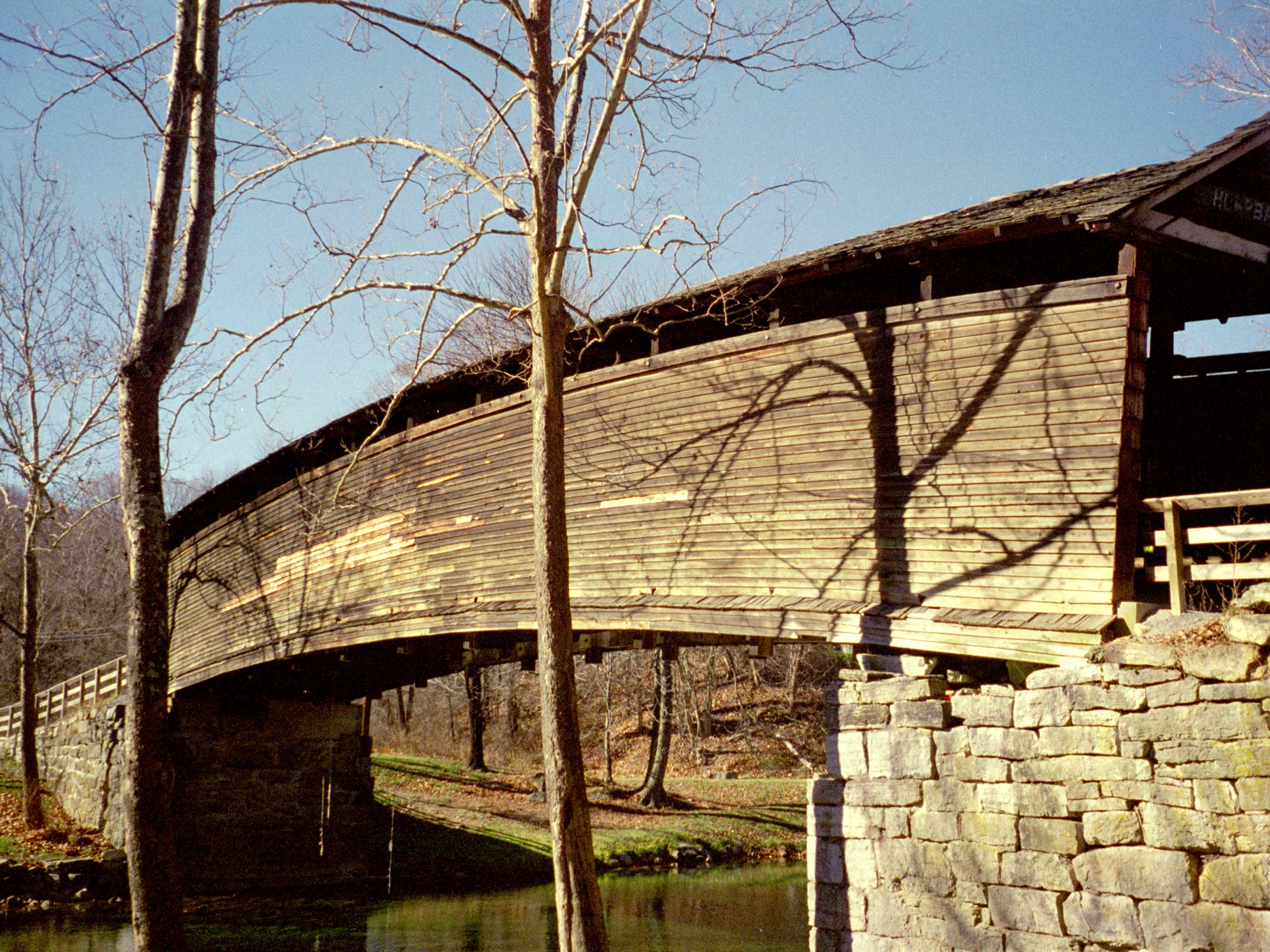- Humpback Covered Bridge
Infobox_nrhp | name = Humpback Covered Bridge

caption = The Humpback Covered Bridge is one of the the last remaining bridges of its type in the U.S.
location =Alleghany County, Virginia , USA
nearest_city =Covington, Virginia
lat_degrees = 37
lat_minutes = 48
lat_seconds = 2
lat_direction = N
long_degrees = 80
long_minutes = 3
long_seconds = 24
long_direction = W
built = 1857
added =October 1 ,1969
refnum = 69000219 cite web|url=http://www.nr.nps.gov/|title=National Register Information System|date=2006-07-08|work=National Register of Historic Places|publisher=U.S. National Park Service]
governing_body =Virginia Department of Transportation The Humpback Covered Bridge located in theU.S. state ofVirginia , is one of the only remainingcovered bridge s in theUnited States that was built higher in the middle than on either end; hence the name of "humpback". The bridge was built in 1857 and is also the oldest remaining covered bridge in the state of Virginia. Its WGCB number is 46-03-01. The bridge spans a tributary of the Jackson River known as Dunlap Creek, for a distance of convert|109|ft. The humpback feature is convert|4|ft higher in the center than at either end. The bridge is located near the city ofCovington, Virginia .NOTE: The
Virginia Department of Transportation officially measures the bridge at convert|100|ft.History
Covered bridges were first built in the 1810s when it was determined that adding a roof over wooden bridges would better protect the decking and support
truss es and increase the lifespan of the bridge. The decking and support systems of the era would last an average of ten years on uncovered wooden bridges. As was later discovered, covered wooden bridges ultimately averaged ten times the lifespan of uncovered ones. Covered bridges were sometimes referred to as "kissing bridges" during the more modest era of the late 19th Century, as the privacy from passing through a covered bridge would allow passengers in horse and buggy an opportunity to kiss each other unobserved.Three bridges stood at approximately the same location as Humpback Covered Bridge does today. The first bridge was built in the 1820s and was destroyed by a flood in 1837. A second bridge built the next year was also damaged beyond repair by a flood on July 13, 1842. The third bridge collapsed in 1856 due to heavy use and fatigue from weathering. None of these earlier bridges were either arched or covered. All three bridges were a part of theJames River and Kanawha Turnpike , a heavily used mountain road that connected theShenandoah Valley with theAlleghany Mountains and areas further west. The current bridge was built in 1857 and the design of both covering and also arching the bridge was hoped to increase the longevity of the bridge by protecting the midsection from future floods and the decking from the ravaging effects of moisture and sunlight. The decking, unlike houses and other structures, could not be painted to prevent deterioration, as the traffic from horses and wagons would quickly remove any available paints of the era.The Humpback Covered Bridge was used from 1857 to 1929, when a steel truss bridge was built for
U.S. Highway 60 immediately to the north. The bridge was abandoned but was sometimes used by a local farmer into the early 1950s to store hay bales. In 1953, the Virginia Highway Department matched a $5,000 fund that had been raised by the Covington Business and Professional Women's Club and the Covington Chamber of Commerce. Five acres surrounding the bridge were purchased and a small wayside park which opened in 1954 was built, allowing easier access. OnOctober 1 ,1969 , the bridge was listed in theNational Register of Historic Places .Construction
Most covered bridges were made of the strongest readily available wood. In the case of the Humpback Covered Bridge, this meant
white oak andhickory . The bridge, as it stands today, has most of the original hand-hewn support timbers and decking that was laid down in 1857, however, most of the walls and roofing have been replaced several times since. Bridge decking was traditionally constructed of wide planks a foot (30.5 cm) or more in width and 4 to 6 inches (10 to 15 cm) in thickness. Most of the support beams are at least a foot thick (30.5 cm). The supports in the bridge utilized hand madehoney locust wood pins to fasten sections of the supports together. The supports incorporate a unique curved multiple kingpost-truss system that is not found in any other surviving wooden bridge in the U.S. The bridge is an original and completely unique design not duplicated anywhere else.Location
Humpback covered bridge is located 3 miles (4.3 km) west of Covington, Virginia adjacent to U.S. Highway 60 off Rumsey Road (SR 600). Exit number 10 in Virginia off of
Interstate 64 is less than convert|1|mi from the bridge site. The convert|5|acre|adj=on wayside park includes a parking area, restrooms, a picnic area and access to Dunlap Creek.References
*
*
*
*ee also
*
List of Virginia covered bridges External links
* [http://www.virginiadot.org/info/faq-covbridge5.asp Humpback Covered Bridge (Virginia Department of Transportation)]
* [http://www.virginia.org/site/description.asp?AttrID=30261&CharID=256287 Humpback Covered Bridge (Virginia Tourism Corporation)]
* [http://www.dalejtravis.com/bridge/virginia/htm/4600301.htm Humpback Covered Bridge (Dale J. Travis)]
Wikimedia Foundation. 2010.
